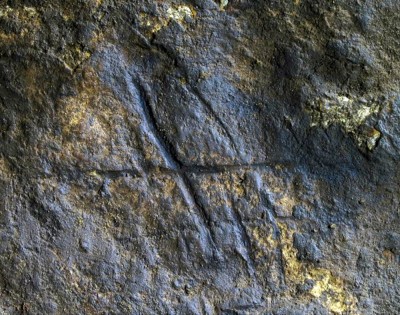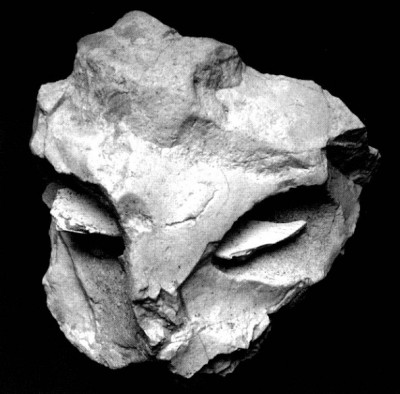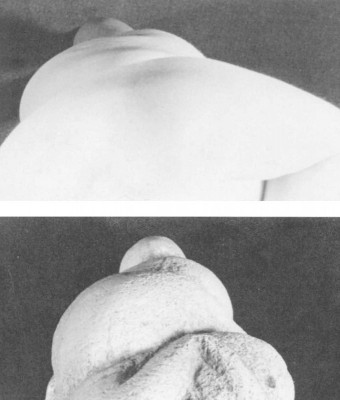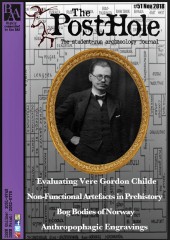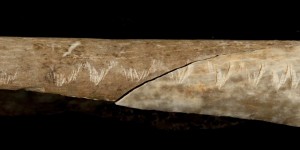Introduction
For archaeologists, the process of understanding prehistoric non-functional material is fraught with ambiguity. When an artefact or structure does not have obvious utility within a prehistoric society, a range of interpretations may present themselves. Those interpretations depend heavily on the individual archaeologist’s theoretical viewpoint, and common debates stem from the Functionalist versus Post-processual movements. Functionalism concerns “the use of an organic analogy in the explanation of societies, with particular reference to system, equilibrium and adaptation” (Hodder 1994, 48). Conversely, Post-processualism – often viewed by some as an ‘anti-science’ - “centres upon the forms of knowledge appropriate to a social science, how society may be conceived (reconciling both patterning or structure and individual action, intention and agency)” (Shanks and Hodder 2007, 3). Due to the strength of both theoretical arguments, it is difficult to determine whether the presence of non-functional material culture indicates the presence of symbolism, or a dependence on the aggregate of physical objects. Archaeologists sometimes argue that both instances have occurred simultaneously throughout prehistory; for example, this is seen in the versatility of Upper Palaeolithic cave art. Factors including societal pressures, changes in subsistence, and symbolic development greatly influenced the extent to which a society produced non-functional material. Nevertheless, it is important to consider biases within prehistoric samples, as survival rates of artefacts and structures may differ depending on post-depositional factors. Therefore, one must consider preservation bias when determining the number of non-functional artefacts and structures present within the record.
Beyond the controversies of Functionalism versus Post-processualism, the question of what is considered ‘non-functional’ must be re-evaluated. Exposure to aspects of the modern world, such as individual experiences and contemporary trends, naturally lead archaeologists to make biased interpretations when examining material culture. Thus, objectivity during interpretation is an illusion which cannot be overcome (Hodder 1999). Within archaeology, artefacts and structures are routinely misconstrued as having no obvious utility, leading them to be labelled as non-functional. However, artefacts and structures can have a symbolic function. For example, following ethnographic studies, Mesolithic amber pendants are thought to have been worn to protect children from evil spirits, and as such they played an active role within that society (Petersen, 2016). The line between symbolism and functionality can be blurred to the extent that they are not considered mutually exclusive. It is important to consider how an artefact or structure was originally perceived when making interpretations; complex symbolism may represent an increased reliance on material culture.
The Middle Palaeolithic
Within scholarly literature, there is little evidence to suggest non-functional structures were habitually produced in the Middle Palaeolithic. The paucity of paleontological data is often misconstrued by archaeologists as proof that the Neanderthals were not capable of complex symbolic thought. However, recent excavations at Gorham’s Cave in Gibraltar have revealed an ostensibly symbolic motif dating to 39 kya. The pattern, (Figure 1), which consists of "a deeply impressed cross-hatching carved into the bedrock of the cave" (Rodríguez-Vidal et al. 2014, 13301) contributes to contemporary narratives within archaeology that suggest the Neanderthals could conceptualise symbolic and ideological ideas. Nevertheless, the speculative nature of this interpretation signifies possible contention within Middle Palaeolithic studies. Rodríguez-Vidal et al. (2014) utilised experimental archaeology to challenge such scepticism and prove the markings were deliberately produced. It was revealed that “the number of strokes needed to carve the complete pattern ranged from 188 to 317” (Rodríguez-Vidal et al. 2014, 13305), indicating that the individual[s] had intended to leave a lasting impression on the cave wall. Furthermore, the quantity of strokes demonstrates that considerable time and skill went into producing the pattern, reinforcing its value to the creator[s]. The “engraving represents the first case in which an engraved pattern permanently marks a space within a habitation area in a cave” (Rodríguez-Vidal et al. 2014, 13305), thus implying that the design held symbolic significance for multiple individuals. This evidence indicates possible societal reverence for the pattern, suggesting the Neanderthals may have created the elaborate structural design as a visual representation of complex symbolic or ideological concepts within the group. Nevertheless, few publications have attempted to interpret the markings; a weakness which should prompt research in the future.
Similarly, the discovery of a proto-figurine ‘mask’ from the Mousterian period at La Roche-Cotard in France, reinforces this idea that Neanderthals produced symbolic, non-functional artefacts. The sculpture consists mainly of a large flint stone featuring a "natural tubular perforation" (Marquet and Lorblanchet 2003, 663), in which bone was purposely wedged to create the appearance of a human face (Figure 2). Careful examination demonstrates that “the object has been worked to give it a more regular shape” (Marquet and Lorblanchet 2003, 664), suggesting the individual[s] who created the mask laboured to produce an intentional image. Furthermore, it is significant that the mask was “not only picked up and brought into the habitation, but was also modified … to perfect its resemblance to a face” (Marquet and Lorblanchet 2003, 667). This, coupled with the time it took to manufacture, indicates the value of the artefact to the creator[s]. In addition, at the time of its production (approximately 32,100 kya), the “existence of beliefs and symbolic behaviour is already firmly attested; people were burying their dead, sometimes with offerings and deposits or spreads of red ochre” (Marquet and Lorblanchet 2003, 669). The mask could thus be viewed as a symbolic “ornament” (Marquet and Lorblanchet 2003, 669), perhaps to embody a deceased individual or idol. Archaeologists may therefore interpret the ‘mask’ as representing complex symbolic ideas which centre on the notion of death. However, it is possible, through active representation of an individual, that the figurine acted as a functional artefact. The value of the item, combined with inferred links to burial practices, suggest that the artefact may have been used in ritualistic performance associated with mortuary rites; it may be argued that this represents a reliance on material culture in ritual practice, although this cannot be corroborated.
The Upper Palaeolithic
The Upper Palaeolithic period is typically concerned with an “unprecedented explosion of creativity” (Gabora 2003, 1). This is due to a substantial increase in the quantity of non-functional artefacts and structures available in the archaeological record; the most eminent being examples of European cave art. Generally, the overwhelming metanarrative is that rock art structures represent attempts to contact the symbolic world. Lewis-Williams (1991) controversially argues for the presence of shamanism within the Upper Palaeolithic, suggesting art was created by individuals who entered trance-like states. This is reinforced by ethnographic examples, such as 20th century descriptions of the San people of southern Africa, who, due to a “shared neurophysiology and interest in fauna” (Hodgson 2006, 27), created images of geometric forms and animals in a process that is likened to shamanism. This indicates that the increasing presence of seemingly non-functional structures represents a measure of symbolic complexity.
However, recent scholarly literature emphasises the importance of functionalist interpretations, arguing that symbolic explanations of cave art are too speculative. Barton et al. (1994, 185) suggests the art has “a social function… of information exchange,” implying that cave structures were utilised to convey messages to the inhabitants. Sugiyama (2001, 223) subscribes to this theory, claiming that cave paintings are a form of symbolic narrative which were vital to the development of oral language. In this way, these archaeological structures can be deemed functional, clearly acting as facilitators to the progression of society. This suggests that individuals increasingly relied on art as material culture in the Upper Palaeolithic to improve their methods of communication. In addition, Steven J. Mithen (1998, 672) suggests environmental stresses may have contributed to the production of cave art. He states that “the subsistence economy came under stress in terms of increases in the fluctuations in yields” (Mithen 1998, 690). Therefore, art could have been utilised by Upper Palaeolithic groups as it enabled the “facilitating of information flows about alternative resources at times of shortfalls” (Mithen 1998, 691). This demonstrates another possible functionalist purpose for cave art, as it acts as a conveyor of dietary information. This is important, as it does not deny the possible symbolic significance of the art in question but argues that functionalist explanations must be addressed to explore all possible interpretations.
Prominent examples of non-functional artefacts in the Upper Palaeolithic are the anthropomorphic statuettes, or ‘Venus’ figurines. Historically, archaeologists have viewed these artefacts as sexual objects, created solely by males, as "clearly no other group would have had such an interest in the female form" (Collins and Onians 1978, 12-14). This is supported by Karel Absolon, who reviewed the figurines in his 1949 publication “The Diluvial Anthropomorphic Statuettes and Drawings, Especially the So-Called Venus Statuettes, Discovered in Moravia: A Comparative Study” (Absolon, 1949). When referring to Venus XIII, he believes that the “statuette shows us that the artist has neglected all that did not interest him, stressing his sexual libido only where the breasts are concerned” (Absolon 1949, 208). This interpretation stresses the figurines’ functionality as ‘prehistoric pornography’. However, some academics argue that this interpretation is sexist. Recent explanations, such as that of LeRoy McDermott, propose the figurines have an alternate symbolic value. To prove that the figurines are symbolic objects, McDermott (1996, 227) effectively uses “photographic simulations of what a modern female sees of herself”. The results demonstrate that the figurine’s shape was carved according to a woman’s “relationship to the eyes and the relative effects of foreshortening, distance, and occlusion” (McDermott 1996, 227). The link between modern women’s interpretations of the female form and the figurines, as shown in Figure 3, cannot be easily dismissed. From this perspective, the statuettes represent reference points for the women to symbolically connect with their bodies through visual art. Therefore, the increasing frequency of these figurines arguably represents complex symbolic and ideological ideas about self-expression. Generally, the non-functional artefacts and structures reviewed for the Upper Palaeolithic imply that symbolism and functionalism can occur in unison. Yet, some archaeologists, like Lewis-Williams, over-romanticize symbolic interpretations, which must be considered when exploring the meaning of non-functional material culture.
The Mesolithic
A phase of prehistory which is often neglected in archaeology is the Mesolithic era. Only recently defined within the discipline, it has been loosely termed by academics as “that period of the Postglacial prior to the introduction of agriculture” (Price 1983, 762). Typically, associations with Mesolithic populations, especially those located in southern Scandinavia, suggest an increasing reliance on material culture. As previously mentioned, amber pendants are often thought to have had a practical application within society. Modern ethnographic studies, such as those referenced by Vang Petersen, indicate that they may have been used as protective charms. In a recent publication, Petersen (2016, 233) comments:
“Among the world’s hunter-gatherer societies there is a general perception that children are particularly vulnerable to the influences of unseen forces. In these societies, a common safeguard against illness and the ‘evil eye’ is to furnish a child’s body and clothing with evil deprecating amulets”
Naturally, archaeologists are aware the pendants do not possess genuine protective qualities, so they are often labelled as non-functional artefacts. However, the concept of function may have been different for prehistoric societies. Mesolithic populations may have held the belief that the pendants were actively protecting their children from harm, much in the same way that Native Americans believe in the properties of the dream catcher: to them, the pendants physically perform a function. There is no tangible evidence to suggest that the pendants did work in this way. Nevertheless, if Mesolithic societies had strong beliefs in their effects, then this could reinforce their reliance on the pendants as material culture. In the Mesolithic, child mortality rates were high due to the challenging nature of their lifestyle. Eleanor Scott states that “a key feature of Ertebolle burial practice is the presence of neonatal and young infants” (Scott 1999, 124). As such, people may have relied on material culture to ensure the safety of their children. In summary, Mesolithic amber pendants may represent a complex symbolic belief system, in which children commit to wearing the jewellery to survive.
Archaeologists such as Jacob Weisdorf often argue that “the rise of Neolithic agriculture is unquestionably one of the most important events in human cultural history” (Weisdorf 2005, 561). Consequently, one might assume that changes in subsistence and mobility during this period may have instigated an increase in the production of non-functional material culture. Such a profound change from hunting to animal husbandry is naturally a risk for any population (Whittle 2009, 84-86). Negative effects can include an intensification of labour, increased vulnerability to disease, and the possibility of crop failure due to harsh weather. To ensure continual and successful yields, populations created ostensibly symbolic artefacts, a proportion of which feature animal imagery and figurines. Conventional arguments suggest that the representation of animal figurines clearly denotes an increase in symbolic material culture. This is corroborated by Nanoglou (2009, 199), who states that people:
“reaffirmed the importance of their mode of subsistence by symbolically stressing the animals they looked after. Thus, their economic dependence on sheep, goats, cattle and pigs would have guided the rendering of these species in clay and the use of these images in various contexts”.
This indicates the value of domestic animals to farming populations and suggests their symbolic significance when represented as clay figurines. Ethnographic studies, such as those conducted by Loze (1983, 11), reinforce the importance of symbolism in ensuring successful returns. Loze states that cultures such as the Giliaks of Amuria used animal imagery to ensure successful hunting and fishing, a practice not dissimilar to Neolithic figurines. Furthermore, increasingly sedentary lifeways, once established, arguably gave individuals more time to produce non-functional objects, as they were not preoccupied by hunting food resources. Colin Renfrew himself “noted that it was only with the coming of the Neolithic that the symbolic use of material culture began to seem familiar to our modern human minds” (Renfrew 1996, cited in Watkins 2002, 3). However, there is “limited knowledge of the role animals played in the symbolic world of the Pre-Pottery Neolithic” (Peters and Schmidt 2004, 216). Consequently, it may not be valid to comment on some of the more drastic symbolic interpretations, for example that animal figurines represent “demons” (Peters and Schmidt 2004, 215). Nevertheless, it is clear that non-functional animal figurines represent increasingly complex symbolism in the Neolithic.
The animal figurines may also have been viewed as functional items which enabled trading within groups. Martin and Meskell (2012, 401) corroborate this idea, suggesting the statuettes play “roles in real everyday activities, such as animal exchange, herding, management, hunting and tracking”. This is a compelling explanation, as the development of farming and housing within societies meant that new concepts about ownership may have been managed through the exchange of figurines. This interpretation suggests an increased reliance on material culture, which was vital to the continuation of early economies. Yet, “it is unlikely that a single interpretation of animal figurines would ever adequately describe the full range of their functions and meanings” (Martin and Meskell 2012, 414). Functionalist and Post-processualist interpretations may both be correct and may have occurred simultaneously. In this way, it is clear that non-functional material culture in the Neolithic can represent an increasing reliance on material culture, as well as complex symbolic and ideological ideas.
An issue that must be addressed when conducting archaeological research, especially when investigating prehistory, is the possibility of biases resulting from post-depositional effects. It is well known that “different forms of site (temporary or permanent, domestic or ritual) have different implications for excavators, while environmental conditions (such as wetness or aridity) affect the nature of deposits and the survival of artefacts and structures” (Greene and Moore 2010, 113). Therefore, answering paleontological questions which focus on quantifying the occurrence of artefacts or structures is difficult. The frequency with which archaeologists find prehistoric material culture naturally varies depending on post-depositional factors, as well as the age of the site. For example, in the Palaeolithic, early “settlements associated with hunter-gatherers were predominantly temporary” (Greene and Moore 2010, 113), often exploiting seasonal resources. This is a problem for archaeologists, as these sites are “particularly susceptible to erosion and other forms of natural disturbance” (Greene and Moore 2010, 113). In addition, caves may be exposed to “natural weathering and sedimentation” (Greene and Moore 2010, 113). Therefore, there will be a low frequency of material culture recovered from this period, which can negatively influence our understanding of prehistoric sites. Conversely, as farming came to replace the hunter-gatherer lifestyle in the Neolithic, populations became more sedentary, enabling the production of a deeper stratification (Whittle 2009, 81). Therefore, survival rates are likely higher. Archaeologists must acknowledge these differences in survival rates to increase the objectivity of their interpretations. If this is not taken into consideration, there may appear to be an increase in the frequency of material culture throughout prehistory, when, in reality, post-depositional factors have affected the sample.
In conclusion, clear examples, such as Neolithic animal figurines, suggest that populations increasingly relied on ‘non-functional’ material culture. This was to cope with societal pressures, which aimed to enhance the practice of mortuary rites, aid communication between individuals, combat high mortality rates in children, and enable management of new complex economies. Similarly, in all periods there is evidence that populations produced ‘non-functional’ material culture which represented symbolic and ideological concepts. Arguably, this can be viewed as a separate response to ease the same societal pressures. Therefore, it is apparent that symbolic and physical measures were utilised concurrently through prehistory as a coping mechanism for stress. However, it is important to acknowledge the possibility of biases resulting from post-depositional effects which impact the frequency with which archaeologists find prehistoric material culture. One must also consider the possibility that functionalism and symbolism are not mutually exclusive. Indeed, examples such as the Mesolithic amber pendants show that both concepts can be applicable to material culture simultaneously. These concepts should be considered during future research.
Bibliography
- Absolon, K., (1949). The Diluvial anthropomorphic statuettes and drawings, especially the so-called Venus Statuettes, discovered in Moravia: a comparative study. Artibus Asiae, 12(3), pp.201-220.
- Barton, C.M., Clark, G.A. and Cohen, A.E., (1994). Art as information: explaining Upper Palaeolithic art in western Europe. World Archaeology, 26(2), pp.185-207.
- Binford, L.R. (1972). An Archaeological Perspective. New York: Seminar Press.
- Collins, D. and Onians, J., (1978). The origins of art. Art History, 1(1), pp.1-25.
- Gabora, L., (2003). Contextual focus: A cognitive explanation for the cultural transition of the Middle/Upper Paleolithic. In (R. Alterman & D. Hirsch, Eds.) Proceedings of the 25th Annual Meeting of the Cognitive Science Society (pp. 432-437), Boston MA, July 31-August 2.
- Greene, K, and Moore, T (2010). Archaeology: an introduction. London: Routledge.
- Hodder, I., (1994). Theoretical archaeology: a reactionary view. In: Pearce, S.M. (ed.) Interpreting Objects and Collections. London: Routledge.
- Hodder, I., (1999). The Archaeological Process: an introduction. Oxford: Blackwell.
- Hodgson, D. (2006). Altered states of consciousness and palaeoart: An alternative neurovisual explanation. Cambridge Archaeological Journal,16(01), pp.27-37.
- Lewis-Williams, J.D., (1991). Wrestling with analogy: a methodological dilemma in Upper Palaeolithic art research. In Proceedings of the Prehistoric Society (Vol. 57, No. 1, pp. 149-162). Cambridge University Press.
- Loze, I., (1983). Akmens laikmeta māksla Austrumbaltijā. Zinātne.
- Martin, L. and Meskell, L., (2012). Animal figurines from Neolithic Çatalhöyük: figural and faunal perspectives. Cambridge Archaeological Journal, 22(03), pp.401-419.
- Marquet, J-C. and Lorblanchet, M. (2003). A Neanderthal face? The proto-figurine from La Roche-Cotard Langeais (Indreet-Loire, France), Antiquity 77(298), pp.661-670.
- McDermott, L., (1996). Self-representation in Upper Paleolithic female figurines. Current Anthropology, 37(2), pp.227-275.
- Mithen, S.J., (1988). To hunt or to paint: animals and art in the Upper Palaeolithic. Man, pp.671-695.
- Nanoglou, S., (2009). Animal bodies and ontological discourse in the Greek Neolithic. Journal of Archaeological Method and Theory, 16(3), pp.184-204.
- Peters, J. and Schmidt, K., (2004). Animals in the symbolic world of Pre-Pottery Neolithic Göbekli Tepe, south-eastern Turkey: a preliminary assessment. Anthropozoologica, 39(1), pp.179-218.
- Price, T.D., (1983). The European Mesolithic. American Antiquity, pp.761-778.
- Rodríguez-Vidal, J., d’Errico, F., Pacheco, F.G., Blasco, R., Rosell, J., Jennings, R.P., Queffelec, A., Finlayson, G., Fa, D.A., López, J.M.G. and Carrión, J.S., (2014). A rock engraving made by Neanderthals in Gibraltar. Proceedings of the National Academy of Sciences, 111(37), pp.13301-13306.
- Scott, E., (1999). The Archaeology of Infancy and Infant Death. Oxford: Archaeopress.
- Sugiyama, M.S., (2001). Food, foragers, and folklore: The role of narrative in human subsistence. Evolution and Human Behavior, 22(4), pp.221-240.
- Vang Petersen, P. (2016) 'Amber pendants, bears and elks', Die Kunde: Zeitschrift für niedersächsische Archäologie 64, pp.219-237.
- Watkins, T., (2002). Memes, memeplexes and the emergence of religion in the Neolithic. Magic Practices and Ritual in the Near Eastern Neolithic, Studies in Early Near Eastern Production, Subsistence, and Environment, 8, pp.41-47.
- Weisdorf, J.L., (2005). From foraging to farming: explaining the Neolithic Revolution. Journal of Economic surveys, 19(4), pp.561-586.
- Whittle, A., (1999). The Neolithic period, c. 4000–2500/2200 BC. The Archaeology of Britain: an introduction from the Upper Palaeolithic to the Industrial Revolution, pp.58.


